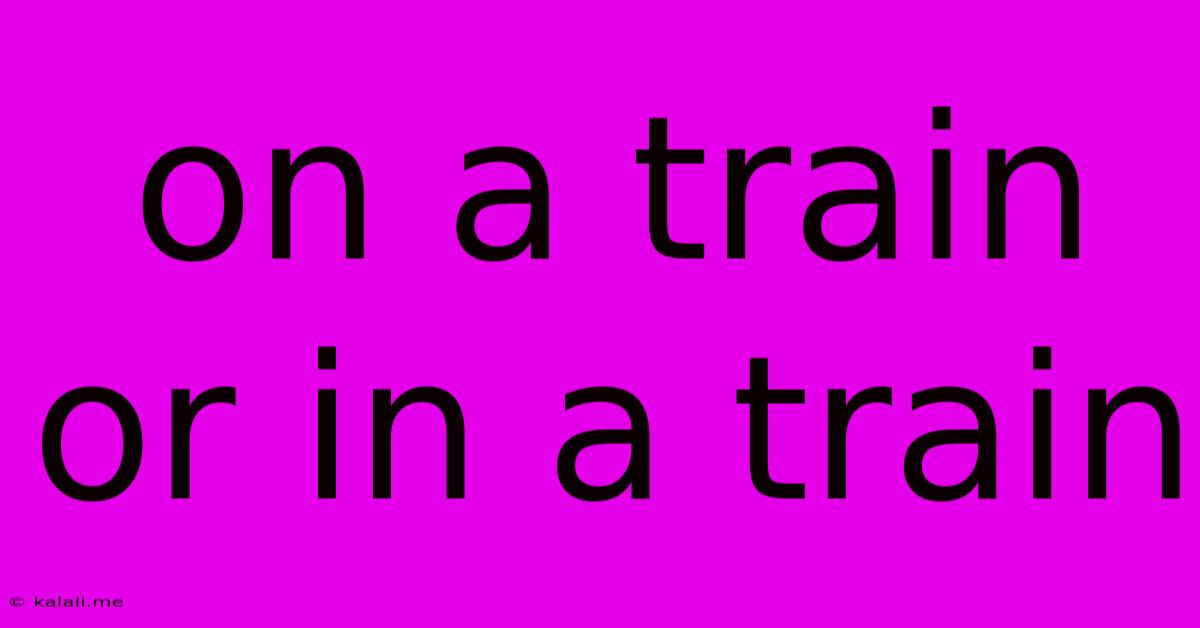On A Train Or In A Train
Kalali
May 19, 2025 · 3 min read

Table of Contents
On a Train or In a Train: Grammar, Style, and Nuance
The seemingly simple question of whether to use "on a train" or "in a train" sparks debate among grammar enthusiasts. While both phrases might seem acceptable in casual conversation, understanding the subtle nuances of preposition usage can elevate your writing and ensure clarity. This article will delve into the correct usage, exploring the grammatical rules and stylistic considerations surrounding this common query.
Meta Description: Learn the difference between "on a train" and "in a train." This guide clarifies the correct preposition usage, explores stylistic choices, and helps you write more precisely. Master the nuances of English grammar.
The most common and grammatically correct preposition to use with "train" is "on." We use "on" to describe something that is positioned on the surface of something else. A train, despite its enclosed compartments, is considered a mode of transportation with a surface—the platforms and carriages. Therefore, you are positioned on the train's surface, whether you're sitting on a seat or standing in the aisle.
Why "In a Train" Is Generally Incorrect
Using "in a train" implies being enclosed within a confined space inside the train. While you are inside the train's carriages, the preposition "in" doesn't accurately reflect the overall context of travel. Think of it this way: you wouldn't say you're "in a car" if you're seated in the driver's seat; you'd say you're "in the car" if you were inside the car's engine compartment or trunk.
Consider these examples:
- Correct: I saw her get on the train. He was reading a book on the train. They met on the train to London.
- Incorrect (generally): I was in a train all day. (Better: I was on a train all day). She waited in a train for an hour. (Better: She waited on the train for an hour; or She waited at the train station for an hour.)
Exceptions and Nuances
There might be very specific exceptions where "in" could be used, but these are rare and usually involve a specific context emphasizing enclosure rather than travel. For example, you might say:
- "The package was securely fastened in a train's luggage compartment."
Here, the focus is on the package's location inside a specific part of the train, not the act of travel itself.
Style and Clarity: Choosing the Right Preposition
While "on a train" is the generally accepted and grammatically sound choice, the key is clarity and style. Ambiguity should always be avoided. If there's any chance of misinterpretation, choose the phrasing that best conveys your intended meaning. In most scenarios related to travel, "on a train" is the clear winner.
Beyond Trains: Applying the Principle to Other Transportation
The principle of using "on" for modes of transportation extends to other vehicles as well:
- On a bus
- On a plane
- On a ship
- On a bicycle
Remember, this refers to being on the vehicle itself during the process of travel.
In conclusion, while minor exceptions might exist, "on a train" remains the preferred and grammatically correct phrase in most situations. By understanding the subtle differences between prepositions, you can enhance your writing's precision and clarity. Mastering these nuances demonstrates a strong command of the English language and improves overall communication effectiveness.
Latest Posts
Latest Posts
-
Revenge Is Dish Best Served Cold
May 19, 2025
-
I Wish I Knew You Before
May 19, 2025
-
Is Mars Closer To The Sun Than Earth
May 19, 2025
-
What Is The Difference Between A Stew And A Casserole
May 19, 2025
-
Ratio Of Mixing Sand And Cement
May 19, 2025
Related Post
Thank you for visiting our website which covers about On A Train Or In A Train . We hope the information provided has been useful to you. Feel free to contact us if you have any questions or need further assistance. See you next time and don't miss to bookmark.